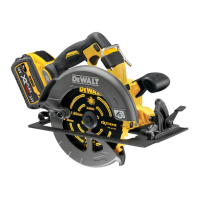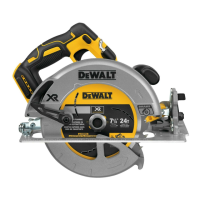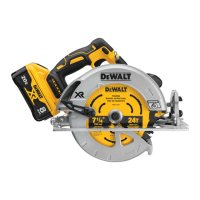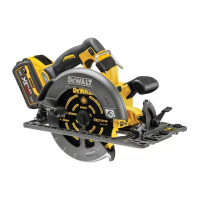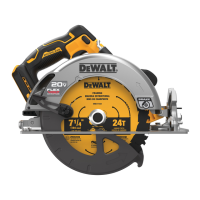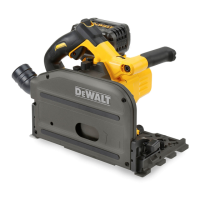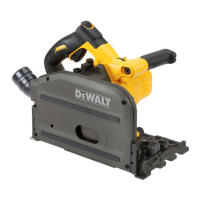ESPAÑOL
23
ʵ Cuando la hoja se pellizca o se atasca fuertemente al
cerrarse la sección de corte, la hoja se para y la reacción del
motor impulsa la unidad rápidamente hacia atrás, hacia
eloperador.
ʵ Si la hoja se tuerce o se desalinea en el corte, los dientes
ubicados en el borde trasero de la hoja pueden penetrar en
la superficie superior de la madera, haciendo que la hoja
trepe, se salga de la sección de corte y salte hacia atrás, hacia
eloperador.
El retroceso es el resultado de un uso inapropiado de la sierra
y/o de procedimientos o situaciones de utilización incorrectos
y se puede evitar tomando las precauciones apropiadas que se
indican a continuación:
a ) Mantenga un agarre firme con las dos manos en
la sierra y posicione los brazos de modo que puedan
resistir las fuerzas de retroceso. Las fuerzas de retroceso
pueden ser controladas por el operador, si se toman las
precaucionesadecuadas.
b ) Cuando la hoja se esté atascando o cuando se
interrumpa un corte por cualquier motivo, suelte el
gatillo y sujete la sierra de modo que esté inmóvil en
el material hasta que la hoja se detenga por completo.
No intente nunca retirar la sierra de la pieza de trabajo
ni tirar de la sierra hacia atrás mientras la hoja esté en
movimiento o se podría producir retroceso. Investigue y
tome medidas correctivas para eliminar la causa de atasco
de lahoja.
c ) Cuando rearranque una sierra en la pieza de
trabajo, centre la hoja de sierra en la sección de corte
y asegúrese de que los dientes de la hoja de sierra no
estén acoplados en el material. Si la hoja de sierra se está
atascando, podría desplazarse o experimentar retroceso
respecto a la pieza de trabajo cuando se arranque lasierra.
d ) Soporte los paneles grandes para minimizar el riesgo
de que la hoja se pellizque y se produzca retroceso. Los
paneles grandes tienden a combarse bajo su propio
peso. Se deben colocar soportes debajo del panel a ambos
lados, cerca de la línea de corte y cerca del borde delpanel.
e ) No use hojas desafiladas o dañadas. Las hojas
desafiladas o con triscado inapropiado producen una sección
de corte estrecha que causa fricción excesiva, atasco de la
hoja yretroceso.
f ) Las palancas de fijación de ajuste de la profundidad
y del bisel de la hoja deben estar apretadas y sujetas
firmemente antes de realizar el corte. Si el ajuste de la
hoja cambia mientras se realiza el corte, dicho cambio podría
causar atasco yretroceso.
g ) Tenga mucho cuidado al serrar en paredes
existentes u otras zonas ciegas. La hoja que sobresale
podría cortar objetos que pueden causarretroceso.
Instrucciones de Seguridad del
Funcionamiento del ProtectorInferior
a ) Compruebe el protector inferior para verificar si se
cierra apropiadamente antes de cada uso. No utilice
la sierra si el protector inferior no se mueve libremente
y no se cierra instantáneamente. No sujete nunca
con abrazaderas ni amarre el protector inferior en la
posición abierta. Si la sierra se cae accidentalmente,
el protector inferior se podría doblar. Suba el protector
inferior con el mango retráctil y asegúrese de que se mueve
libremente y no toca la hoja ni ninguna otra pieza, en todos
los ángulos y profundidades decorte.
b ) Compruebe el funcionamiento del resorte del
protector inferior. Si el protector y el resorte no están
funcionando correctamente, se les debe hacer servicio
de ajustes y reparaciones antes de la utilización. El
protector inferior podría funcionar con dificultad debido a que
haya piezas dañadas, depósitos gomosos o una acumulación
deresiduos.
c ) El protector inferior se debe retraer manualmente
sólo para realizar cortes especiales, tales como “cortes
por penetración” y “cortes compuestos”. Suba el
protector inferior por el mango retráctil y, en cuanto
la hoja entre en el material, se debe soltar el protector
inferior. Para todas las demás operaciones de aserrado, el
protector inferior debe funcionarautomáticamente.
d ) Asegúrese siempre de que el protector inferior esté
cubriendo la hoja antes de dejar la sierra en un banco
de trabajo o en el piso. Una hoja que se esté moviendo
por inercia hasta detenerse y no esté protegida hará
que la sierra se desplace hacia atrás, cortando todo
aquello que esté en su camino. Tenga en cuenta el tiempo
que se requiere para que la hoja se detenga después de soltar
elinterruptor.
Instrucción Adicional de Seguridad
ADVERTENCIA: Nunca modifique la herramienta
eléctrica, ni tampoco ninguna de sus piezas. Podría producir
lesiones corporales odaños.
ADVERTENCIA: Use SIEMPRE lentes de seguridad.
Los anteojos de diario NO SON lentes de seguridad. Utilice
además una cubrebocas o mascarilla antipolvo si la
operación de corte genera demasiado polvo. SIEMPRE LLEVE
EQUIPO DE SEGURIDADCERTIFICADO:
• protección ocular ANSI Z87.1 (CAN/CSA Z94.3),
• protección auditiva ANSI S12.6 (S3.19),
• protección respiratoria NIOSH/OSHA/MSHA.
ADVERTENCIA: Algunas partículas de polvo generadas
al lijar, serrar, esmerilar y taladrar con herramientas eléctricas,
así como al realizar otras actividades de construcción,
contienen químicos que el Estado de California sabe que
pueden producir cáncer, defectos congénitos u otras
afecciones reproductivas. Ejemplos de estos químicosson:
• plomo de algunas pinturas en base a plomo,
• polvo de sílice proveniente de ladrillos y cemento y otros
productos de albañilería, y
• arsénico y cromo provenientes de madera
tratadaquímicamente.
Su riesgo de exposición a estos químicos varía, dependiendo
de la frecuencia con la cual realiza usted este tipo de trabajo.
Para reducir su exposición a estas sustancias químicas: trabaje
en una zona bien ventilada y llevando equipos de seguridad
aprobados, como mascarillas antipolvo especialmente
diseñadas para filtrar partículasmicroscópicas.
• Evite el contacto prolongado con polvo generado
por el lijado, aserrado, pulido, taladrado y otras
actividades de construcción. Vista ropas protectoras y
lave las áreas de la piel expuestas con agua y jabón. Si
permite que el polvo se introduzca en la boca u ojos o quede
sobre la piel, puede favorecer la absorción de productos
químicospeligrosos.
ADVERTENCIA: La utilización de esta herramienta puede
generar polvo o dispersarlo, lo que podría causar daños
graves y permanentes al sistema respiratorio, así como otras
lesiones. Siempre use protección respiratoria aprobada por
NIOSH (Instituto Nacional de Seguridad y Salud en el Trabajo)

